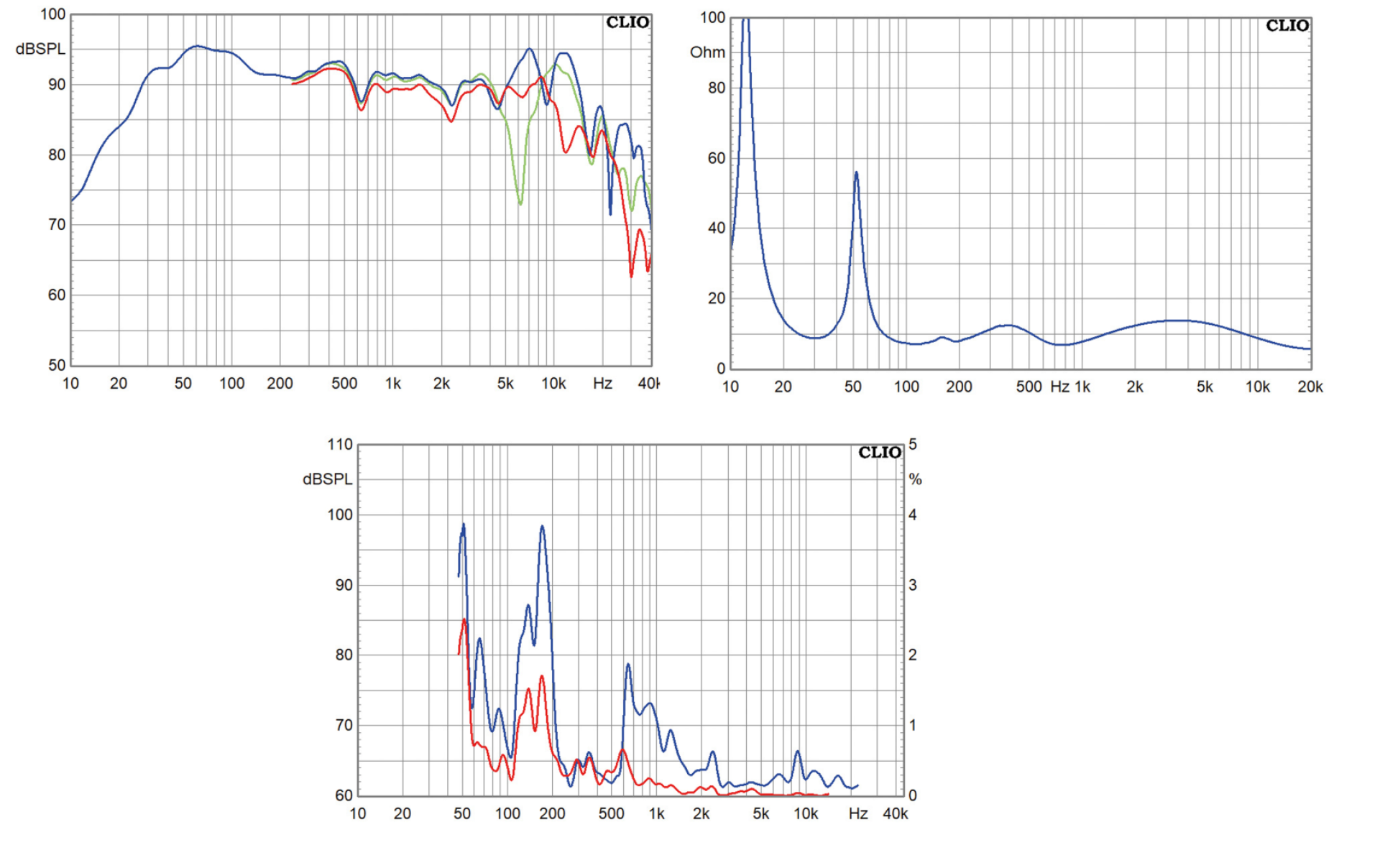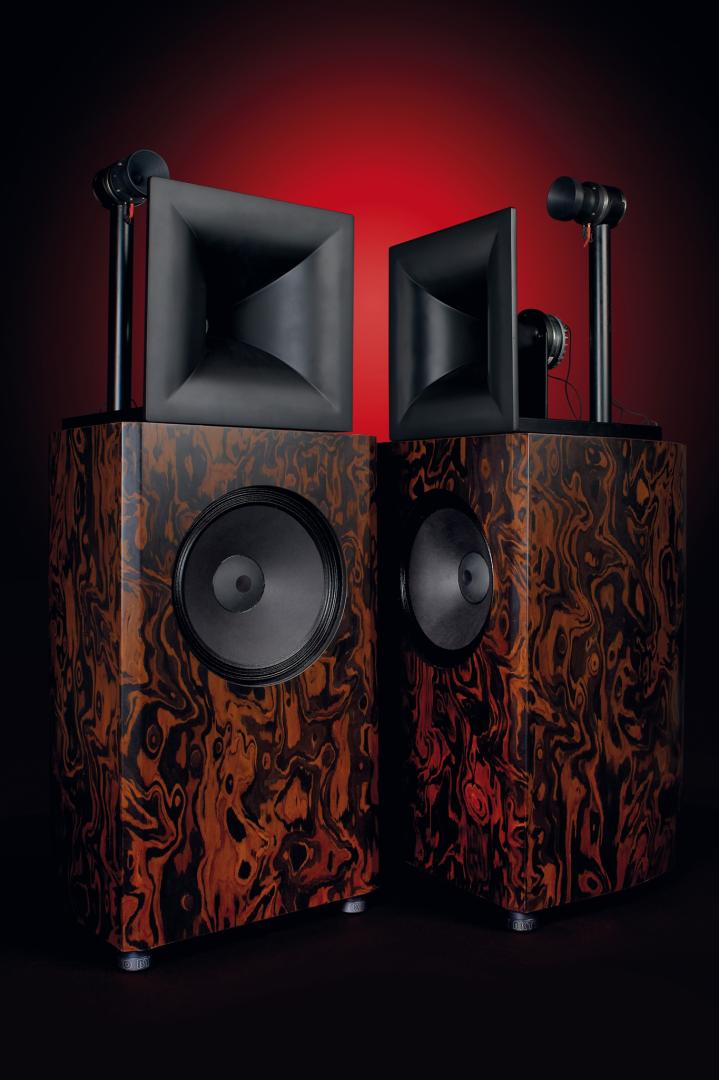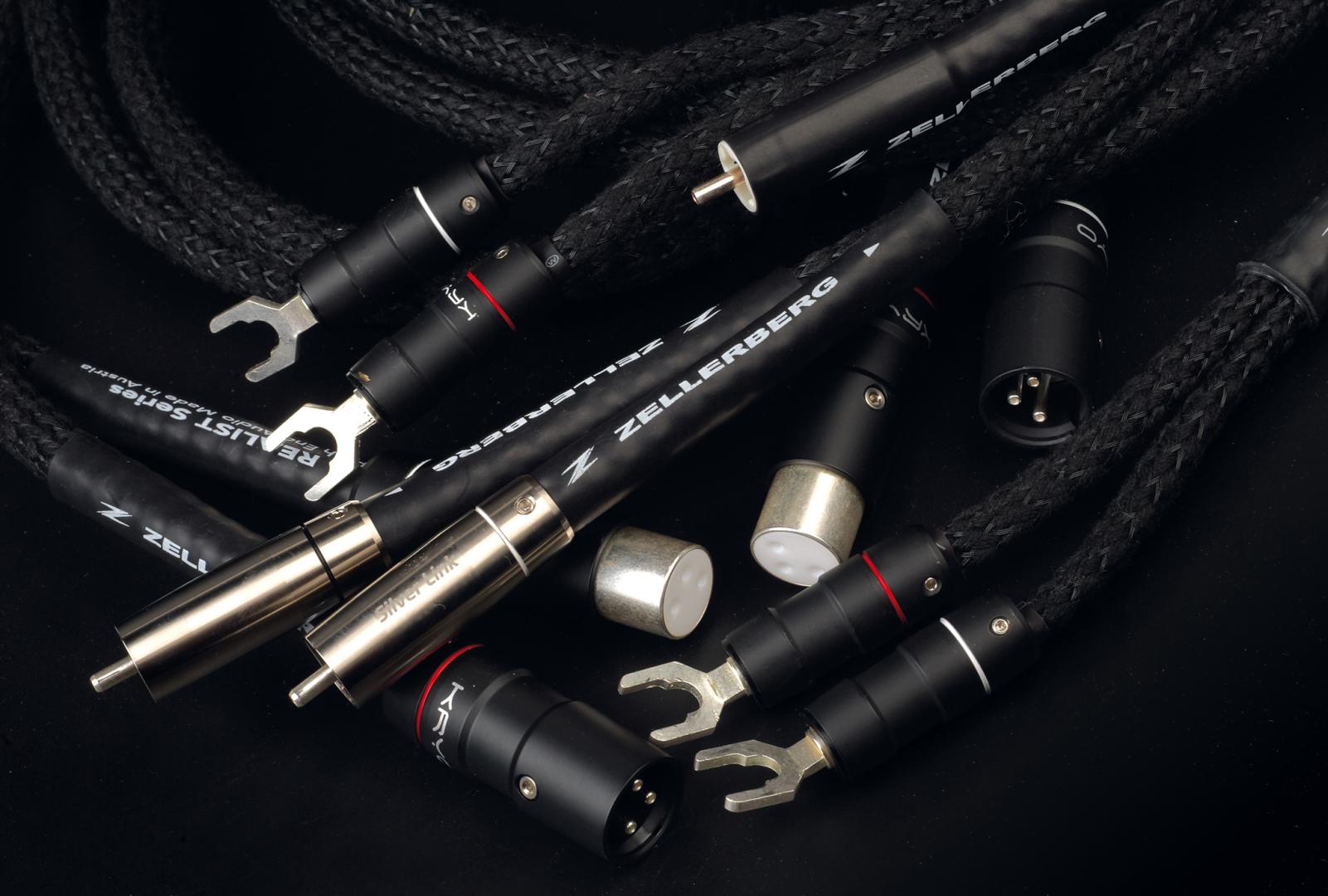I´ve got some bad news for you: "real" speakers have to look exactly like these. And if you think this is going to be a very nerdy story, then you´re on the right track.
Loudspeakers Supravox KL15 Heritage
The moment I spotted the brand new floorstanding speaker from French speaker manufacturer Supravox at this year‘s High End in Munich, I knew I had to have one (actually: two). The KL15 Heritage simply pushed a few buttons for me that I could hardly resist: a large-volume bass reflex cabinet with a 15“ cone that looks very much like a stone-aged Altec driver, a square midrange horn that is very reminiscent of the legendary KL-L302 Klangfi lm combination. Both are things that will inevitably bring tears of ecstasy to the eyes of vintage loudspeaker fans.
Historical
Okay, one thing at a time: Supravox? Do you need to know that? Absolutely. The history of the small but mighty loudspeaker specialist goes back to the time before the Second World War. The Supravox brand name first appeared in the 1950s. The French manufacturer built super-fine full-range loudspeakers, which were initially used in radios and televisions from a wide range of manufacturers. To this day, you can buy them individually and do all the work yourself. Recently, however, there are also ready-made loudspeakers with high audiophile standards. Three versions of a powerful fifteen-inch woofer are now also being produced based on the famous model. One of these derivatives is used in the loudspeaker we are about to fall in love with here. Ambitious DIY enthusiasts can also purchase these gems individually; the company‘s own webshop currently lists the woofers for 1239 euros each. This is certainly not a bargain, but neither are the alternatives from Great Plains Audio in the USA. I warned you, this is going to be tough stuff here ...
Concept
Before we get completely lost in the details, let‘s first talk about the big picture. This manifests itself in the form of an almost one and a half meter high floorstanding speaker, which clearly does not follow the latest design standards, but is somewhere between a vintage look and a DIY project of the more elaborate variety. Added to this is a price tag of a slightly unpleasant 42,000 euros for a pair, which is likely to limit the customer base from the outset to the most hardened fans of such gems. It is a classic passive loudspeaker with a healthy efficiency of a realistic 93 decibels at a fairly high impedance (around ten ohms on average), which should be a suitable partner for all kinds of tube stuff, especially as the impedance curve is pleasantly unagitated.
Low frequency
With a width of over half a meter and a similar depth, the woofer cabinet is undoubtedly the most expansive component of the KL15 Heritage.
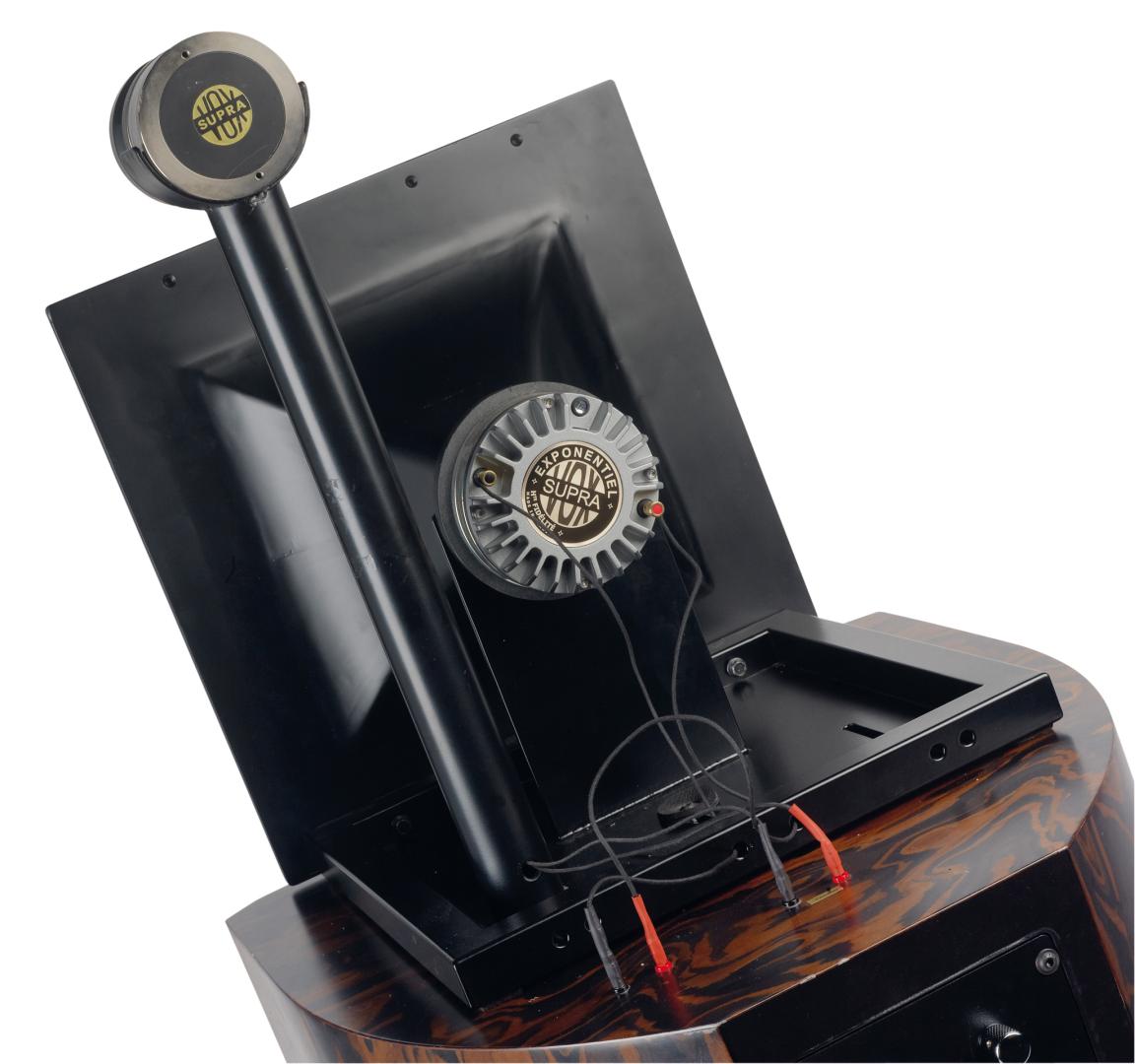 The metal holder for the two pressure chamber drivers turned out a bit robust, but does its job
The metal holder for the two pressure chamber drivers turned out a bit robust, but does its job The star of the show is the fifteen-inch driver, which is mounted from the inside in the old-fashioned way and has all the characteristics that we so sorely miss in modern woofers today: powerful drive, low moving mass, soft cone suspension. This allows you to go very deep into the frequency response cellar if you are willing to provide sufficient air volume. This has been achieved here in the form of a solidly braced birch multiplex cabinet. The rounded side walls and the crosssection that tapers towards the rear are the only concessions to the spirit of modernity and provide additional stability. The woofer can be accessed via a „service flap“ at the bottom of the cabinet. The cabinet was finished in a modern and environmentally correct synthetic veneer. Its appearance is not necessarily to everyone‘s taste, nor is the finish (primarily on the edges of the cabinet). As this is a very early production model, I am quite sure that changes and improvements are still possible. We have no objections to the fine driver, whose three-inch voice coil is set in motion by a classic AlNiCo magnet. The ventilation through an opening in the dust cap is just as much a reference to the original as the multiple folded fabric surround and the classic paper cone. Two large-volume reflex tubes on the back of the speaker provide the necessary bass, and the structurally rather simple crossover also finds its place in this compartment.
In the middle For „normal“ hi-fi fans, the mid-range horn is certainly the most unusual detail on the Supravox speaker. Despite its square shape, it is a spherical wave guide; the contour was simply converted to a square format. The legendary design was created in Germany in the 1950s. At the time, Siemens‘ audio division operated under the name Klangfilm and was also responsible for this gem. The original horn was designed to be connected to a one-inch pressure chamber driver; the version used here is shorter and fitted with a two-inch driver. I‘m probably not giving away any secrets when I say that it originates from the US manufacturer Radian. Its construction has nothing to do with vintage, it is a state-of-the-art design with a neodymium drive and a three-inch diameter beryllium diaphragm. The horn itself is made in Germany by the small but fine manufacturer Lamar Audio and consists of a highly damping resin that is molded into shape using a casting process.
High frequencies At around six kilohertz, the square horn transfers to a no less exotic ring radiator, for which Lamar Audio is also responsible. The 25 millimeter diameter diaphragm is driven by an impressive external AlNiCo magnet, which also ensures that the driver „sticks“ relatively securely in its somewhat robust-looking mount. The cone of the driver is made of good old phenolic resin, which JBL used „back then“ to create the most resilient compression drivers on the market. The developer deliberately left the last shred of upper cut-off frequency and achieved exactly the sound he wanted in the interaction between the cone and the phase plug, which was the result of many tests.
And otherwise The midrange and tweeter horns are held in place by a welded steel construction, with the whole assembly being connected to the bass cabinet by a single screw. A slotted hole allows the mid-range and tweeter to be moved in depth relative to the bass. The tweeters, mounted on top of a tube, are enthroned a little above the action and are also arranged off-center. Whether they belong on the outside or inside depends on your individual listening situation. In our listening room, placing the tweeters inside has proven to be the right choice.
Sound Apart from that, setting up the Supravoxes is quite simple. They are quite easy to place and the two rotary switches, which can be used to slightly adjust the midrange and tweeter horns to the room, were allowed to remain in the center position; their effect is definitely minimal. The drive was ultimately provided by the big Soulnote A-3 integrated amplifier, which will definitely be reported on separately. The combination with the KL15 Heritage is a musical highlight, the likes of which I rarely experience. First it was the turn of the indestructible Paul Kuhn and his trio to introduce me to his legendary late live recording „Live At Birdland“. Which worked shockingly well. The first thing that strikes you is the excellent imaging ability of the speakers. The boss sits perfectly in the middle, the distance between the voice and the piano is exactly traceable. And even at extremely low levels, the imaging remains perfectly stable. The next striking feature is the tonal precision of the KL15 Heritage. The timbres are spot on, with not a trace of typical horn coloration. The transitions between the three branches are completely inconspicuous, which I consider to be perhaps the greatest design achievement in the conception of this loudspeaker. Sometimes you might get the impression that the sound is a little restrained at the very top. However, every gently struck cymbal, every brush on a drum convinces you otherwise: this part of the spectrum sounds super-fine and precise. The enthusiasm hardly wanes with Steely Dan‘s „Gaucho“, on the contrary: the very first notes of „Babylon Sisters“ pamper you with a warm, profound but lightning-fast bass. If proof were needed that something like this is also possible with a bass reflex design - here it is. The opening choir vehemently tears an imaginary curtain away from the stage, the voices sound incredibly crisp and clean – this is how horns should sound. What would I criticize about this speaker? Absolutely nothing. The transducer is an absolute dream from top to bottom and I don‘t want to rule out that one or two details will have consequences for my DIY activities.
Measurements: The Supravox also cuts a fine figure in front of the microphone. The amplitude frequency response shows a slight upward slope, which is consistent with the sound impression. The bass range has a slight maximum at around 60 Hertz, but it continues below this to at least 30 Hertz. In the treble range, the sound is somewhat unsteady, but this is not acoustically significant. The omnidirectional behavior is very good, the average efficiency is around 93 decibels at 2.83 volts. The impedance chart reports a pleasant average of ten ohms, the curve looks linearized - good news for tube operators. The distortion behavior is unproblematic, the slight increase in second-order distortion in the crossover range between bass and midrange is probably due to reflections in the midrange horn
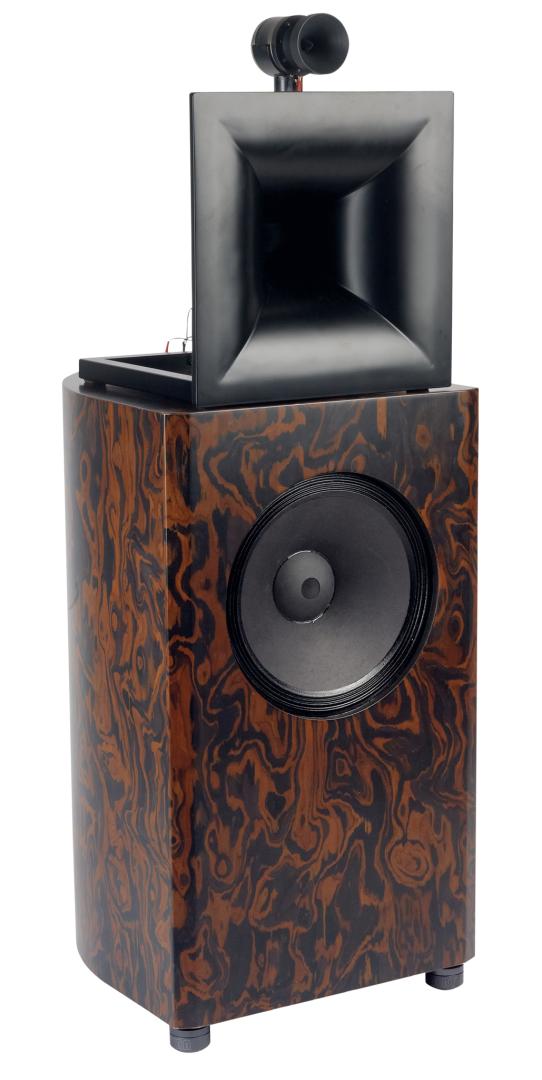 The KL15 Heritage is an almost one and a half meter high piece of furniture that needs to be integrated into the living space first
The KL15 Heritage is an almost one and a half meter high piece of furniture that needs to be integrated into the living space first
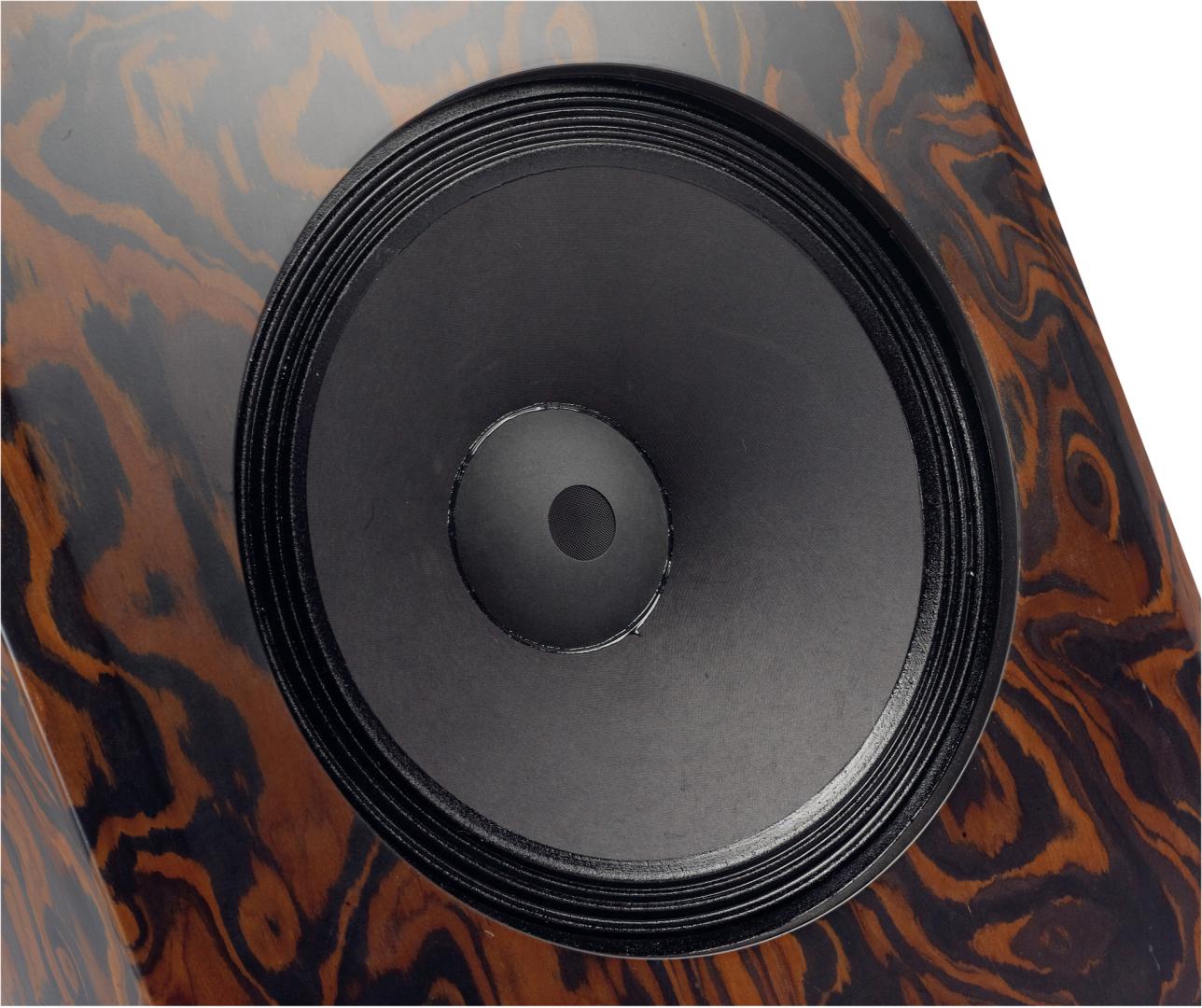 The woofer looks confusingly similar to a vintage type from Altec
The woofer looks confusingly similar to a vintage type from Altec
 The metal holder for the two pressure chamber drivers turned out a bit robust, but does its job
The metal holder for the two pressure chamber drivers turned out a bit robust, but does its job
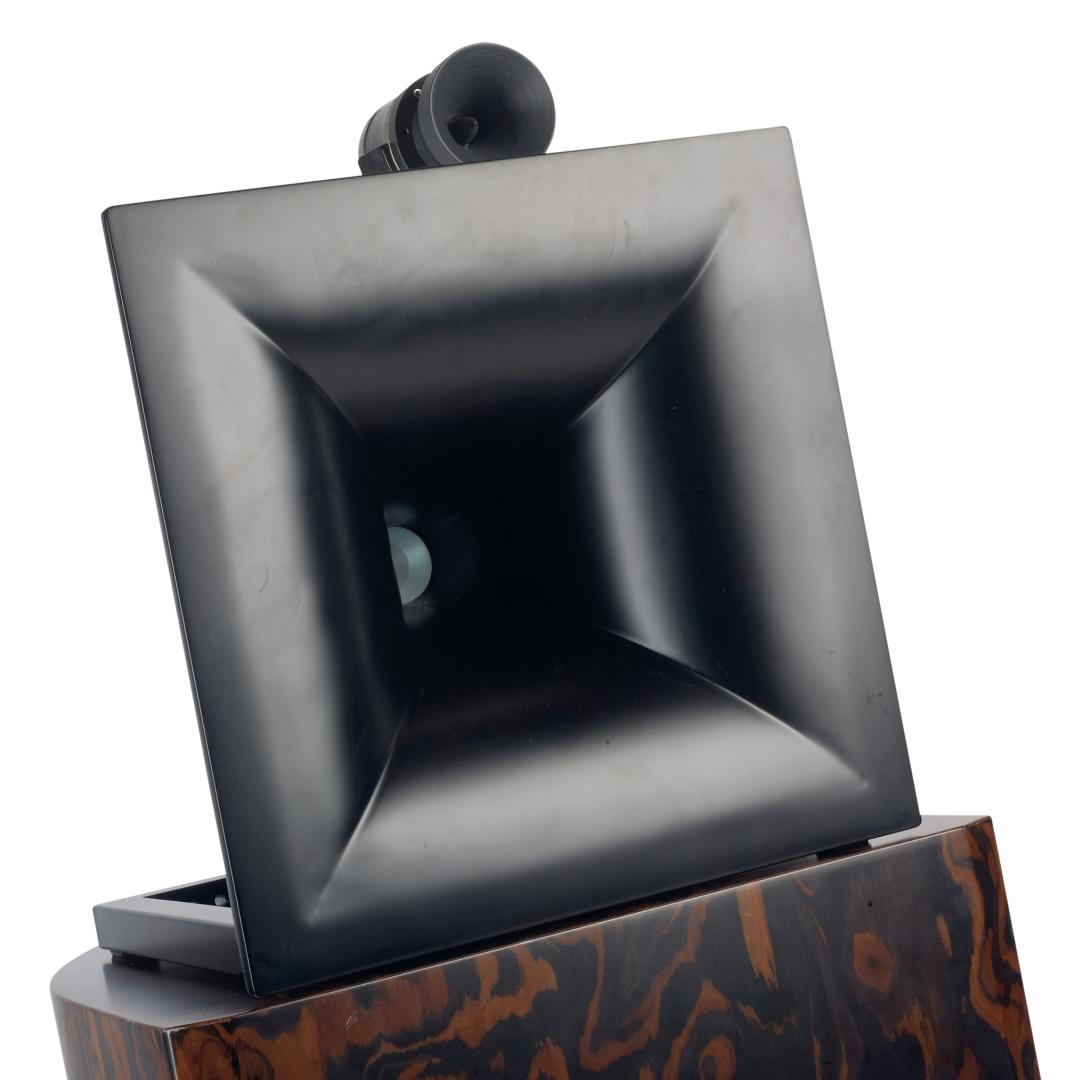 The cast horn based on the Klangfilm model is sound is an absolute dream
The cast horn based on the Klangfilm model is sound is an absolute dream
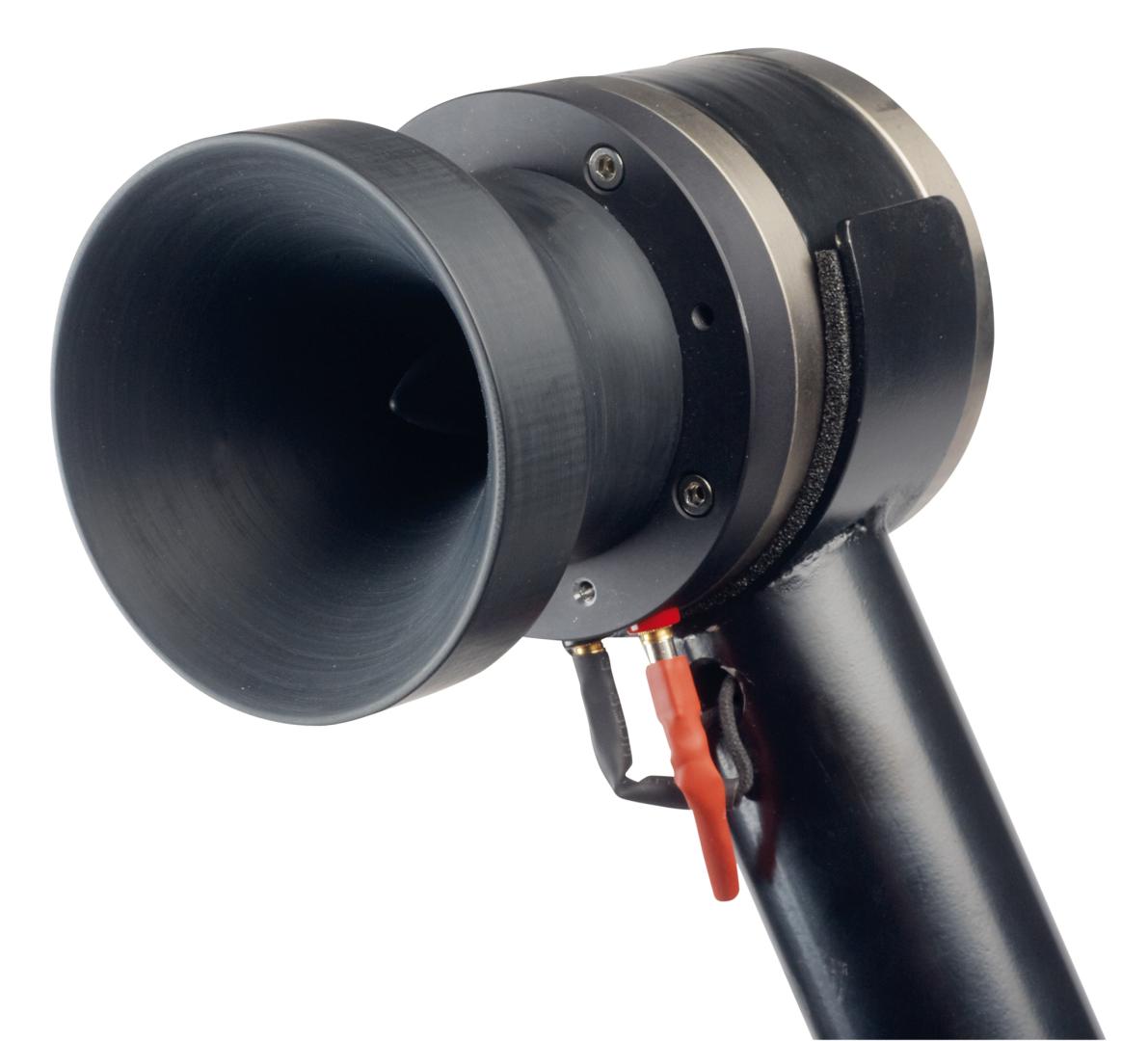 The small pressure chamber driver takes over from around 6.5 kilohertz the sound radiation
The small pressure chamber driver takes over from around 6.5 kilohertz the sound radiation
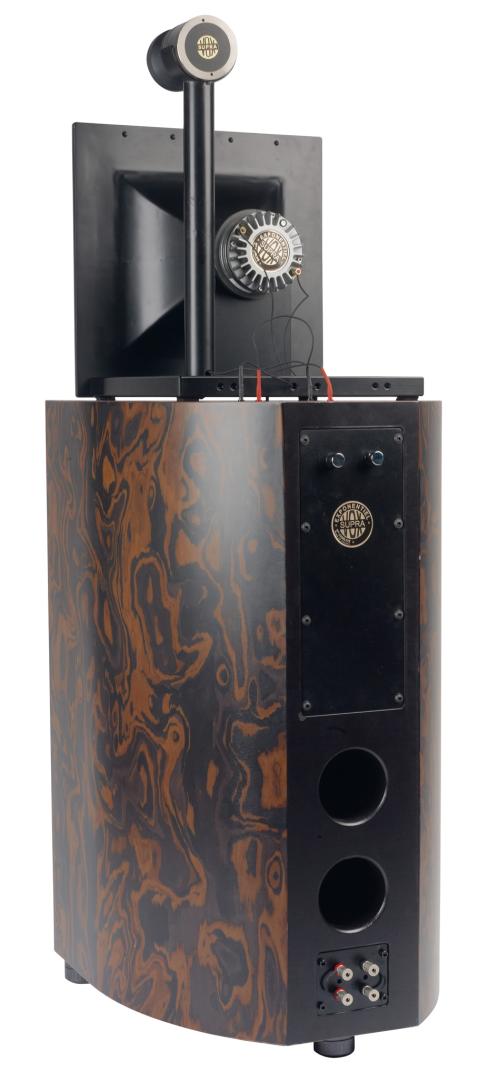 The two potentiometers at the top of the on the back allow a subtle level correction for the midrange and tweeter
The two potentiometers at the top of the on the back allow a subtle level correction for the midrange and tweeter
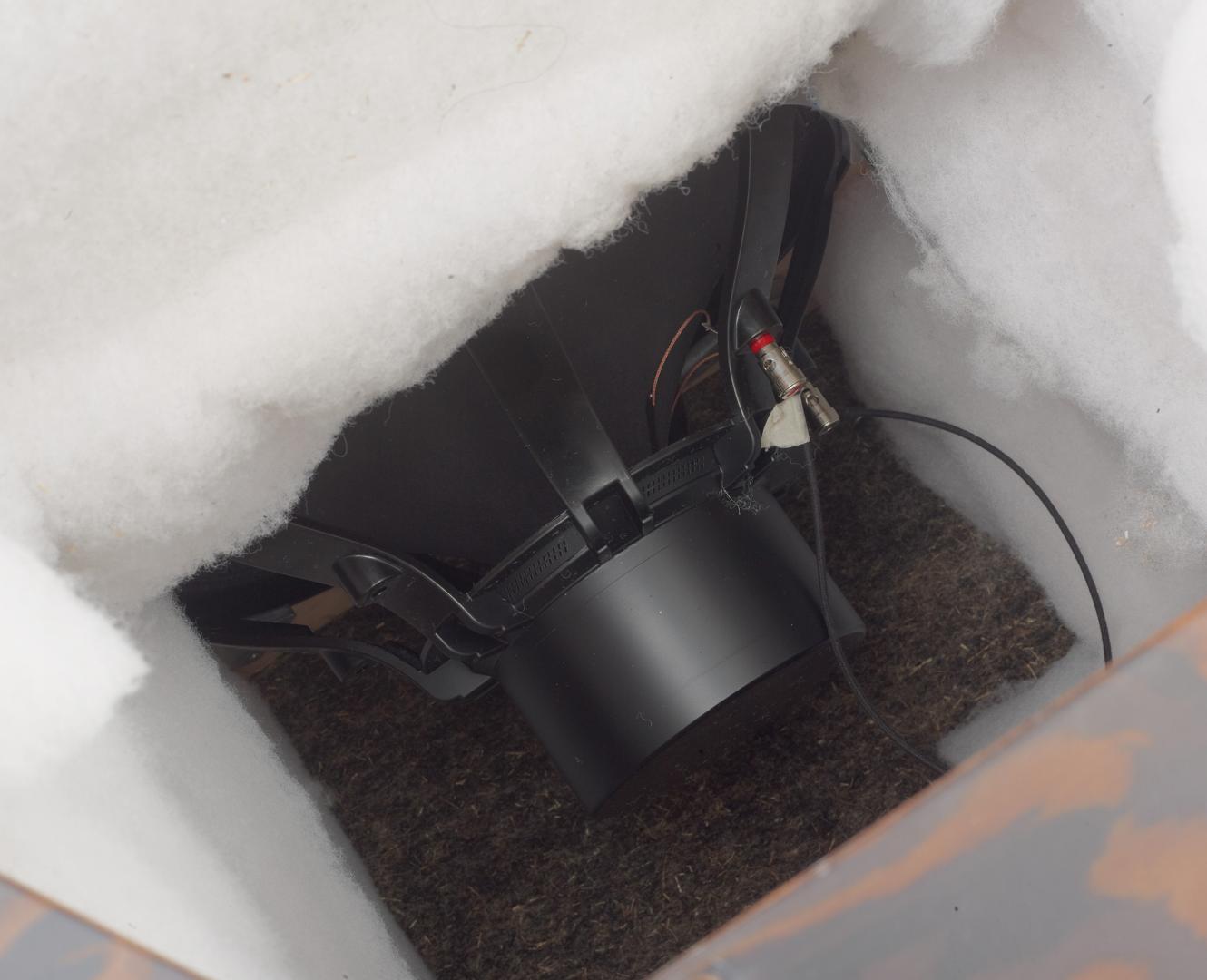 The bass can only be accessed through a flap in the floor. Note the powerful AlNiCo magnet
The bass can only be accessed through a flap in the floor. Note the powerful AlNiCo magnet
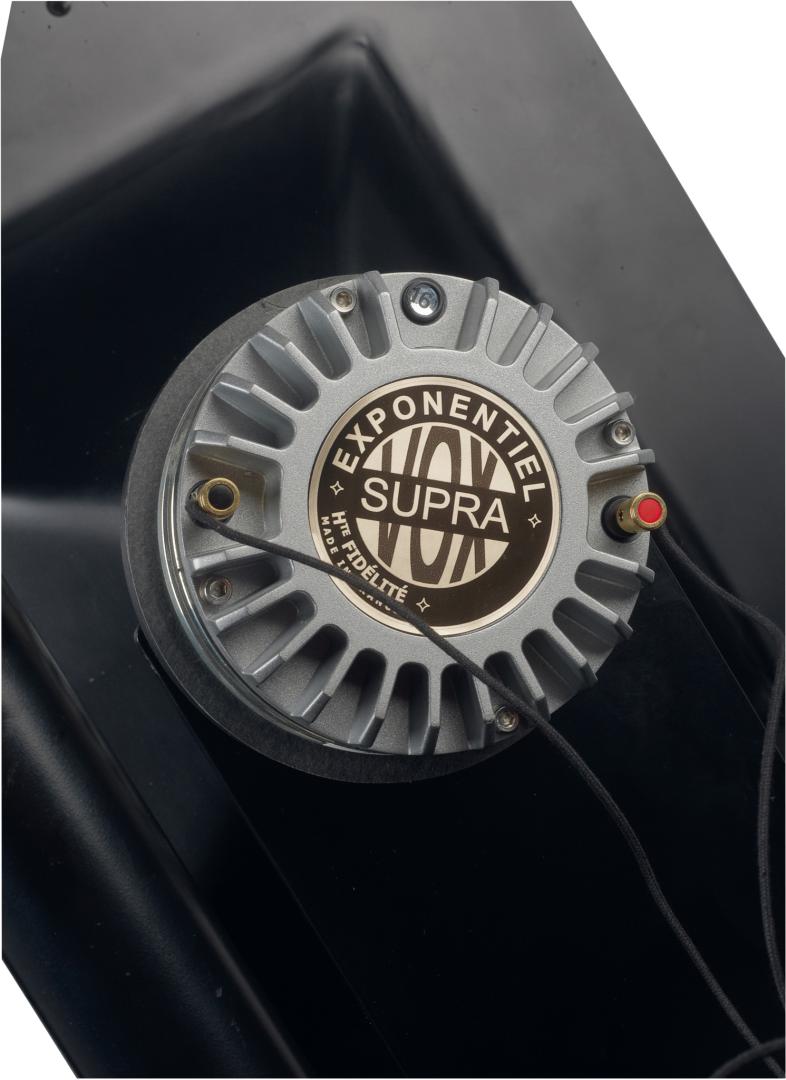 The mid-range driver is supplied by US specialist Radian
The mid-range driver is supplied by US specialist Radian
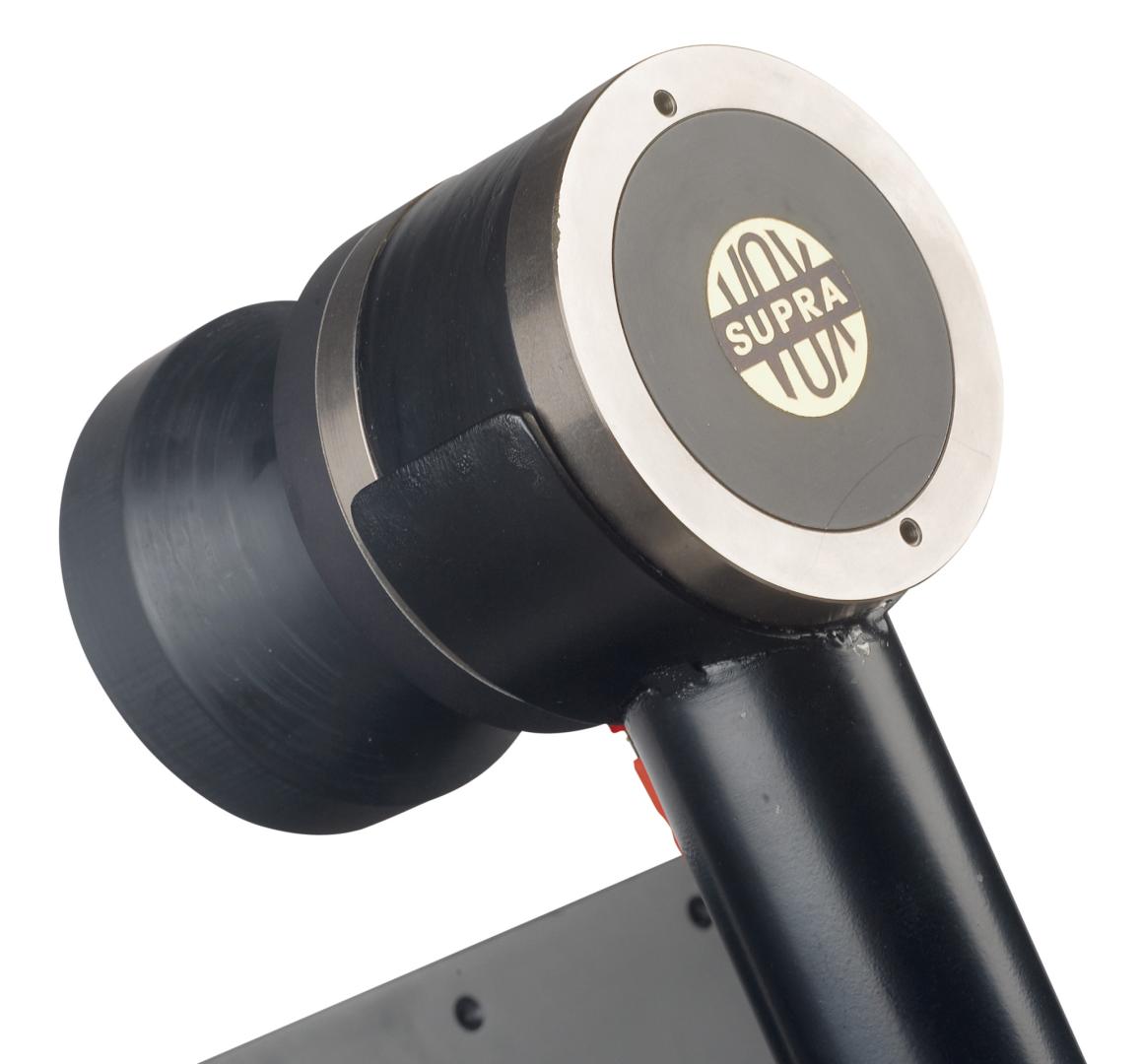 The super tweeter comes from German specialist Lamar Audio
The super tweeter comes from German specialist Lamar Audio
